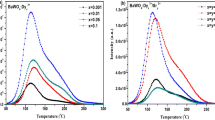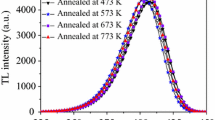Abstract
In this work, we report the dosimetric characterization and the evaluation of the kinetics parameters of trapping states of ZnO phosphors obtained thought a chemical route. Pellet-shaped samples present thermoluminescence (TL) properties suitable for use as radiation detectors and dosimeters. The glow curve is composed of three peaks with the maxima at about 412, 530 and 600 K. The last peak is located into the temperature range considered most suitable for TL dosimetry applications. The activation energies and the frequency factors of trapping states involved in the TL emission were evaluated using the initial rise method, peak shape methods, and glow curve deconvolution (GCD). The values of the activation energies obtained using peak shape methods agree with those computed from GCD.







Similar content being viewed by others
References
Azorín J, Furetta C, Scacco A (1993) Preparation and properties of thermoluminescent materials. Phys Status Solidi 138:9–46. doi:10.1002/pssa.2211380102
Furetta C (2003) Handbook of thermoluminescence. World Scientific, Singapore. doi:10.1142/9789812564863
Özgür U, Alivov YI, Liu C et al (2005) A comprehensive review of ZnO materials and devices. J Appl Phys 98:041301. doi:10.1063/1.1992666
Burlacu A, Ursaki VV, Skuratov VA et al (2008) The impact of morphology upon the radiation hardness of ZnO layers. Nanotechnology 19:215714. doi:10.1088/0957-4484/19/21/215714
Cruz-Vázquez C, Burruel-Ibarra SE, Grijalva-Monteverde H et al (2007) Thermally and optically stimulated luminescence of new ZnO nanophosphors exposed to beta particle irradiation. Radiat Eff Defects Solids 162:737–743. doi:10.1080/10420150701482089
Secu CE, Sima M (2009) Photoluminescence and thermoluminescence of ZnO nano-needle arrays and films. Opt Mater (Amst) 31:876–880. doi:10.1016/j.optmat.2008.10.025
Sahu D, Acharya BS, Bag BP et al (2010) Probing the surface states in nano ZnO powder synthesized by sonication method: photo and thermo-luminescence studies. J Lumin 130:1371–1378. doi:10.1016/j.jlumin.2010.02.049
Pal PP, Manam J (2013) Evaluation of kinetics parameters in the X-irradiated TSL studies of RE3+-doped (RE = Eu, Tb) ZnO nanorods for dosimetric applications. Radiat Phys Chem 88:7–13. doi:10.1016/j.radphyschem.2013.03.023
Reddy AJ, Kokila MK, Nagabhushana H et al (2012) Structural, EPR, photo and thermoluminescence properties of ZnO: Fe nanoparticles. Mater Chem Phys 133:876–883. doi:10.1016/j.matchemphys.2012.01.111
McKeever SWS, Moscovitch M, Townsend PD (1995) Thermoluminescence dosimetry materials: properties and uses. Nuclear Technology Pub, England
Garlick GFJ, Gibson AF (1948) The electron trap mechanism of luminescence in sulphide and silicate phosphors. Proc Phys Soc 60:574–590. doi:10.1088/0959-5309/60/6/308
Randall JT, Wilkins MHF (1945) The phosphorescence of various solids. Proc R Soc Lond Ser A Math Phys Sci 184:347–364
Borbón-Nuñez HA, Cruz-Vázquez C, Bernal R et al (2014) Thermoluminescence properties of sintered ZnO. Opt Mater (Amst) 37:398–403. doi:10.1016/j.optmat.2014.06.034
Grossweiner LI (1953) A note on the analysis of first-order glow curves. J Appl Phys 24:1306. doi:10.1063/1.1721152
Lushchik ChB (1956) The investigation of trapping centers in crystals by the method of thermal bleaching. Sov Phys JETP 3:390
Halperin A, Braner AA (1960) Evaluation of thermal activation energies from glow curves. Phys Rev 117:408–415. doi:10.1103/PhysRev.117.408
Balarin M (1975) Direct evaluation of activation energy from half-width of glow peaks and a special nomogram. Phys Status Solidi 31:K111–K114. doi:10.1002/pssa.2210310259
Balarin M (1979) Half-width and asymmetry of glow peaks and their consistent analytical representation. J Therm Anal 17:319–332. doi:10.1007/BF01914023
Chen R (1969) Glow curves with general order kinetics. J Electrochem Soc 116:1254–1257. doi:10.1149/1.2412291
Chen R (1969) On the calculation of activation energies and frequency factors from glow curves. J Appl Phys 40:570. doi:10.1063/1.1657437
Pagonis V, Kitis G, Furetta C (2006) Numerical and practical exercises in thermoluminescence. Numer Pract Exerc Thermolumin. doi:10.1007/0-387-30090-2
McKeever SWS (1980) On the analysis of complex thermoluminescence. Glow-curves: resolution into individual peaks. Phys Status Solidi 62:331–340. doi:10.1002/pssa.2210620139
Acknowledgements
H. A. Borbón-Nuñez kindly thanks DGAPA-UNAM for a postdoctoral fellowship position.
Author information
Authors and Affiliations
Corresponding authors
Rights and permissions
About this article
Cite this article
Borbón-Nuñez, H.A., Iriqui-Razcón, J.L., Cruz-Vázquez, C. et al. Thermoluminescence kinetics parameters of ZnO exposed to beta particle irradiation. J Mater Sci 52, 5208–5215 (2017). https://doi.org/10.1007/s10853-017-0761-y
Received:
Accepted:
Published:
Issue Date:
DOI: https://doi.org/10.1007/s10853-017-0761-y




